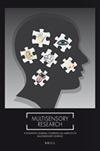Audio–Visual Cross-Modal Correspondences of Perceived Urgency: Examination through a Speeded Discrimination Task
IF 1.5
4区 心理学
Q3 BIOPHYSICS
引用次数: 0
Abstract
When presenting information in vehicle cockpits, it is essential to convey an appropriate urgency to the drivers. Perceived urgency has been investigated over the years for each modality, particularly audition and vision. However, the interaction between the modalities of perceived urgency has rarely been examined. To expand the insight into the design application of information presentation, we investigated the audio–visual interaction of perceived urgency using a priming task that involved speeded visual-target discrimination. A total of 60 auditory stimuli were created using a synthesizer. In addition, 13 color squares were used as visual stimuli. Three auditory stimuli with high, medium, and low perceived urgency, and two visual stimuli with high and low perceived urgency were selected based on a subjective evaluation test using a seven-point scale. A priming task was conducted to examine the cross-modal interaction of perceived urgency. Auditory stimuli were presented as prime stimuli, and the participants were asked to discriminate the visual target as quickly as possible. The results revealed that auditory stimuli with high and low perceived urgency facilitated responses to each visual stimulus with similar perceived urgency relative to each visual stimulus with different perceived urgency. The auditory stimulus with medium perceived urgency also facilitated responses to the visual stimulus with high perceived urgency relative to low. The present study shows that cross-modal correspondences can be observed when the stimuli are selected based on their subjective perceived urgency.感知紧迫性的视听跨模态对应:通过快速辨别任务的检验
当在驾驶舱内展示信息时,必须向驾驶员传达适当的紧迫性。多年来,人们对每一种方式,特别是听觉和视觉的感知紧迫性进行了调查。然而,很少审查感知紧迫性的方式之间的相互作用。为了进一步深入了解信息呈现的设计应用,我们使用涉及快速视觉目标辨别的启动任务来研究感知紧迫性的视听交互作用。使用合成器总共产生了60种听觉刺激。另外,13个颜色方块作为视觉刺激。采用7分制主观评价测试,选择具有高、中、低感知紧迫性的3种听觉刺激和具有高、低感知紧迫性的2种视觉刺激。一项启动任务被用来检验感知紧迫性的跨模态相互作用。听觉刺激作为启动刺激,并要求参与者尽快区分视觉目标。结果表明,相对于具有不同紧迫感的视觉刺激,具有高紧迫感和低紧迫感的听觉刺激促进了对具有相似紧迫感的视觉刺激的反应。紧迫感程度中等的听觉刺激对紧迫感程度较高的视觉刺激的反应也较低。本研究表明,当刺激物的选择是基于其主观感知的紧迫性时,可以观察到跨模态对应。
本文章由计算机程序翻译,如有差异,请以英文原文为准。
求助全文
约1分钟内获得全文
求助全文
来源期刊

Multisensory Research
BIOPHYSICS-PSYCHOLOGY
CiteScore
3.50
自引率
12.50%
发文量
15
期刊介绍:
Multisensory Research is an interdisciplinary archival journal covering all aspects of multisensory processing including the control of action, cognition and attention. Research using any approach to increase our understanding of multisensory perceptual, behavioural, neural and computational mechanisms is encouraged. Empirical, neurophysiological, psychophysical, brain imaging, clinical, developmental, mathematical and computational analyses are welcome. Research will also be considered covering multisensory applications such as sensory substitution, crossmodal methods for delivering sensory information or multisensory approaches to robotics and engineering. Short communications and technical notes that draw attention to new developments will be included, as will reviews and commentaries on current issues. Special issues dealing with specific topics will be announced from time to time. Multisensory Research is a continuation of Seeing and Perceiving, and of Spatial Vision.
 求助内容:
求助内容: 应助结果提醒方式:
应助结果提醒方式:


